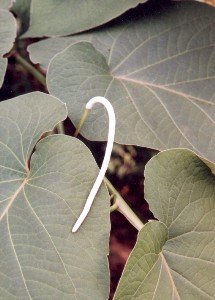Rootbeer Plant
by Valerie (November 18, 2002)
A plant for shade, rootbeer plant (Piper auritum) is quite an interesting perennial in our garden. This native of southern Mexico goes by quite a number of common names, including Hoja santa, sacred pepper, Mexican pepperleaf, Juniapa, and Veracruz pepper. It is poorly suited to our climate, demanding far more water than I can give it, but does weather freezes okay, dying back to the ground, but emerging in the spring. I have found that it is an excellent barometer plant to tell me when I need to water. If it is upright, absolutely no water is necessary. If it is wilted over, but the stems are still upright, it is still not necessary to water any of the other plants but I should think about it. However, when it lies completely flat on the ground, it is time to water. The rootbeer plant spends most of the summer lying flat on the ground.

Aside from the water requirement drawback, the plant is quite a showy foliage addition. When treated right, it can grow over 10 feet tall, but usually averages about 6 feet in this area. In its native habitat (rainforest) it never freezes back and so can get to be about 18 feet tall. In spite of having to start from scratch every spring, the rootbeer plant still manages to produce impressive leaves. They are wide and heart-shaped and can reach about a foot in length. I'm always a bit amazed that the leaves can completely wilt and be lying on the ground, like sheets waiting for the laundry, but add lots of water and they perk up and look like new again. The plants do produce underground rhizomes, thereby spreading, but they are not hard to contain or pull out. In fact, the rhizomes make it easy to propagate. While I've seen the rootbeer plant flower, it seems to have trouble producing fruit in our climate. The flower stalk is a plain white stem, 4 - 6 inches long, that grows upright above the leaves. This is covered with minute flowers that are difficult to see. After the flowers are fertilized, the stem drops down and round fruits form, looking something like grapes on a stick. I've never seen any fruits on plants in this area. Perhaps the flowers are not fertilized. Rootbeer plant is so named because of the distinctive anise or licorice scent of its leaves. This odor comes from a compound called safrole which is a large component of the oil within the foliage. While rootbeer plant leaves are used in traditional Mexican cooking, safrole, which is also produced by other plants, including sassafras, is a known carcinogen. The oil is sold commercially, and the plants have been imported to many tropical regions around the world, where they are used for cooking, as folk remedies for various ailments, and as an ingredient in a type of fermented drink. Although the plant can become an invasive weed in tropical regions, our climate is definitely on the edge of its range and it is easy to control, providing a pleasant exotic highlight to gardens. |